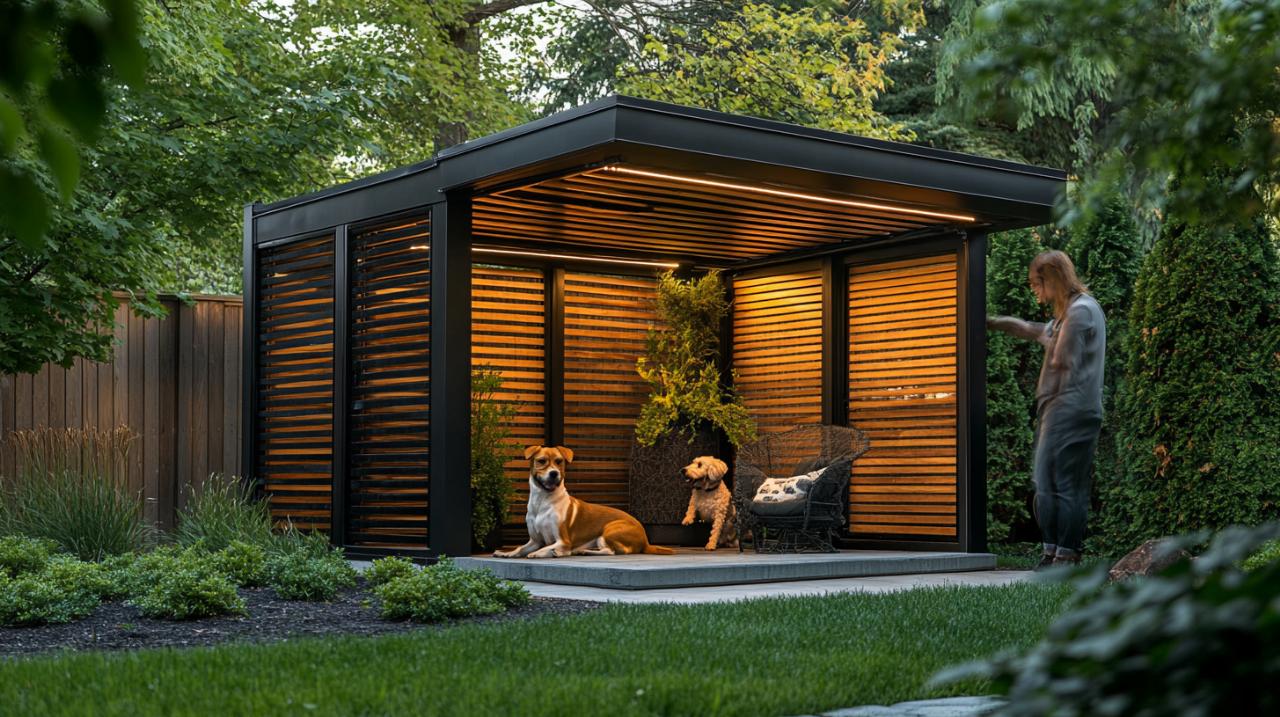Creating a comfortable outdoor retreat for your dogs is more than just a practical endeavour; it is a genuine expression of care that ensures your companions remain safe and content regardless of the weather. When you have two dogs sharing your life, a thoughtfully constructed shelter becomes even more important, offering them a shared haven that promotes warmth during chilly evenings and provides respite from the scorching summer sun. Embarking on a diy dog shelter project allows you to tailor every element to suit the specific needs of your pets, from the choice of materials to the precise dimensions that guarantee comfort and security.
Planning your two-dog shelter: essential considerations
Before you gather your tools and materials, it is essential to devote time to planning every aspect of your shelter. Careful thought at this stage ensures that your finished structure will serve its purpose effectively and stand the test of time. Understanding the unique requirements of a double dog house begins with recognising that both pets need adequate space to move, rest, and interact without feeling cramped. Providing a dedicated space for pets to rest is crucial for their well-being, and when designing for multiple pets, this principle takes on added significance. You must consider not only the physical dimensions but also the layout that will best accommodate your dogs' temperament and habits.
Size is critical for comfort and health, so take the time to measure each dog carefully. You should account for their height when standing, their length when lying down, and the space they require to turn around comfortably. Experts recommend adding at least twenty per cent more room for medium and large breeds to ensure they do not feel confined. A shelter that is too small can cause stress and discomfort, while one that is excessively large may fail to retain warmth during colder months. Sharing a space promotes socialisation and strengthens bonds between your pets, which is a wonderful benefit of a double dog house. At the same time, some dogs appreciate having their own corner, so you might consider internal divisions to give each animal a sense of personal territory within the shared structure.
Choosing the Right Location and Positioning
The success of your shelter depends greatly on where you place it in your garden or yard. Proper installation and location are important for safety and longevity, so choose a spot that offers natural protection from the elements. Look for an area that is shielded from prevailing winds, as constant exposure to strong gusts can make the interior uncomfortable and even compromise the structural integrity over time. Position the entrance away from the direction of the usual winds for added protection, ensuring that rain and snow do not blow directly into the shelter. Moderate sunlight is beneficial, as it helps to keep the interior dry and warm without overheating the space during summer.
Raising the structure off the ground is another crucial step that prevents water accumulation and deters unwanted critters from taking up residence underneath. A raised platform also improves air circulation, which contributes to a healthier environment inside the shelter. Avoid placing the doghouse in noisy areas close to busy roads or machinery, as excessive noise can cause anxiety and prevent your pets from resting peacefully. By selecting a calm, sheltered spot with good drainage and minimal disturbance, you create an inviting retreat that your dogs will be eager to use.
Determining Proper Size and Dimensions for Two Dogs
Getting the dimensions right is perhaps the most important aspect of building a shelter for two dogs. Each dog should be able to stand, turn about, and lie down without restriction, which means you need to account for the combined space requirements of both animals. Measure the height of your tallest dog from the ground to the top of the head, then add several inches to ensure comfortable headroom. For the floor area, consider the length of each dog when stretched out and provide enough width so they can lie side by side if they choose, or move around each other without difficulty.
Remember that a well-designed double dog house allows for flexibility in how your pets use the space. Some dogs prefer to curl up close together, especially during cold weather when shared body heat provides additional warmth during cold months. Others may wish to have their own corner, so leaving enough room for them to settle at opposite ends is wise. Internal divisions can benefit dogs with different personalities, offering a compromise between shared accommodation and individual comfort. By taking accurate measurements and planning the layout with care, you ensure that your diy dog shelter project results in a structure that truly meets the needs of both pets.
Materials and Construction: Building a Weather-Resistant Haven

Once you have finalised your plans, it is time to select the materials that will form the foundation of your shelter. The choice of construction materials has a direct impact on the durability, weather resistance, and overall comfort of the finished doghouse. You want to strike a balance between affordability, ease of construction, and long-term performance, ensuring that your shelter remains functional and attractive for years to come.
Selecting durable, weatherproof building materials
Wood offers good thermal insulation but requires maintenance such as varnishing and protection against humidity and insects. Treated timber is a popular choice for many pet owners, as it combines natural insulation properties with reasonable durability. However, you must commit to regular upkeep, applying weatherproof sealants and inspecting the structure periodically to prevent rot and pest infestation. If you prefer a low-maintenance option, plastic is easy to clean and weather-resistant, though it may have inferior thermal insulation compared to wood. Plastic housing can be a practical choice for warmer climates or if you plan to add supplementary insulation to the interior.
For the roof, consider using bitumen roofing, which offers superior protection against rain, snow, and sun. Bitumen is waterproof and durable, resisting temperature changes and UV radiation, making it an excellent choice for a structure that will face the elements year-round. A well-constructed roof with a slight slope ensures that rainwater runs off quickly, preventing leaks and damp patches inside the shelter. Pay attention to every joint and seam, as even small gaps can allow moisture to penetrate, compromising the comfort and health of your pets.
When assembling, read instructions carefully and use appropriate tools to ensure that every component is securely fastened. Double-check there are no sharp edges or hazards inside the shelter that could injure your dogs. Sand down any rough surfaces and ensure that nails or screws are flush with the wood to prevent snagging or scratches. Quality construction materials and careful workmanship are the keys to building a dog shelter that is both safe and long-lasting.
Incorporating insulation and ventilation features
A truly effective shelter must regulate temperature and manage moisture, which means incorporating insulation and ventilation into your design. Good ventilation is key to keep out damp and prevent things from getting too hot, especially during the warmer months. Install vents near the roof or at the top of the walls to allow hot air to escape while drawing in cooler air from below. This circulation helps to maintain a comfortable interior climate and reduces the risk of mould or mildew developing inside the structure.
Insulation is equally important for keeping your dogs warm during winter. You can line the walls and roof with foam board or reflective insulation, ensuring that it is securely attached and covered to prevent your pets from chewing or disturbing it. The insulation should be thick enough to provide meaningful thermal protection without reducing the interior space to the point of discomfort. Some builders also add a layer of weatherproof fabric or plywood over the insulation to create a smooth, easy-to-clean interior surface.
Chuck in some comfy bedding like straw or blankets to make it snug for your dogs, providing an additional layer of warmth and comfort. Straw is an excellent choice because it resists moisture and provides natural insulation, while blankets offer softness and can be easily washed and replaced. Whichever bedding you choose, make sure to change it regularly to maintain hygiene and freshness. Give the shelter a once-over regularly to keep it in tip-top shape, checking for signs of wear, damage, or pest activity. Routine maintenance ensures that your diy dog shelter project continues to serve its purpose effectively, protecting your pets in any climate and giving you peace of mind that they have a safe, comfortable place to call their own.







